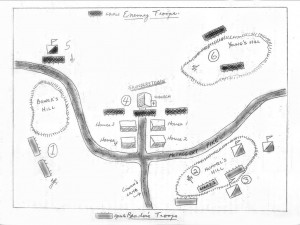Just in time for the weekend, Tactical Problem #4 from War Game Digest, December 1960.
Tactical Problem #4 (Battle of Saunderstown)
Background and Rules: The Readers Force is attacking Saunderstown, which enemy troops hold. Any troops inside houses receive more firepower, but have no extra melee power. Houses may be blown up with a dice roll of 3 or 6, and half of any troops inside are killed.
All cannons as shown on the map on the Hills are within cannon range of the village. Hills thus will assume tactical importance.
You may use more, or fewer, troops than specified, but the proportions should remain the same
Objective: For Readers troops to either seize the village and hold it -or- to isolate the enemy troops within the village, forcing them to surrender.
Forces
Readers Troops: At Point 1 (see map) are two 15 man Line Infantry regiments and one cannon. At Point 2, another gun overlooks Saunderstown, and the range is to the Church from the position on the map. On Hummel Hill (position 3) from left to right are: 1 Line Infantry regiment of 15 men, 1 regiment of 15 Light Infantry, 1 regiment. of 15 Line Infantry and three Troops of cavalry, each 10 men strong.
Enemy Troops: At Point 4 (Saunderstown) are located three infantry regiments, 15 men strong each. (These troops may be in the houses: one regiment per house only). At Point 5 there is one 15 man infantry regiment, 1 cannon and 1 cavalry troop of 12 men. On Young’s Hill is one gun (range to House #4) and two 15 man infantry regiments.
Totals
Readers Troops: 75 infantry, 30 cavalry, 2 guns .
Enemy Troops: 90 infantry, 12 cavalry, 2 guns.
Note: The Reader`s Light Infantry Regiment moves at 1 1/2 Infantry Move speed, and has half again as much firepower as an Infantry Regiment.


